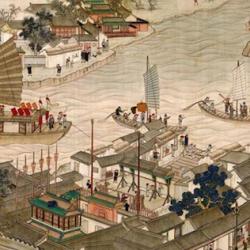How did religion survive and revive in China? Answering that question in Religion in China, Fenggang Yang sketches the outlines of a political-economic sociology of religion.
Like many sociologists of religion, he rejects the theory of secularization. Modernity has not proven to be the solvent of religious faith that many thought it would be. Yet Yang isn’t satisfied with the market alternative proposed by some, such as Rodney Stark.
Because market theories of religion focus on Europe and the US, they highlight institutionalized forms of religion and ignore more amorphous non-institutionalized religious expressions. Further, drawing from market economics, market approaches to religious sociology ignore politics and the way that political regimes affect the religious markets by favoring some and suppressing other religious expressions. For these reasons, market approaches cannot explain the Chinese experience of the last century.
In place of a single market theory, Yang proposes a triple market theory. In China, and in many other places, there is a “red” market of state-approved religions, and an underground “black” market of state-suppressed religions. Consuming religion in the red market is comparatively risk-free; buying on the black market is high-risk. But between these alternatives is a large area that Yang identifies as a “gray” market, which “consists of all religious and spiritual organizations, practitioners, and activities with ambiguous legal status” (87).
Restrictive, repressive regulation of the market doesn’t eliminate religious desires or “needs,” and in fact the more repressive the regime the larger the gray market grows (90). Repression actually creates the triple market, and thus helps to ensure the survival of religion under repressive conditions. Repression failed, and so did the forcible substitution of the cult of Mao for traditional religions. Again, the state’s restrictive policies created a shortage of religious supply, which now cannot meet the explosive religious demand. Repressive politics drove religious demand underground, where it seems to have lay “dormant” until circumstances changed (141-2). Religion is still in short supply, as the state continues to restrict sites for religious events, clerical training, and publication of religious books (149-54).
He estimates that today, as the Chinese government has loosened restrictions, there are 100 million Chinese in the red market, between 100 and 200 million in the black market. He asks if the other 1 billion other Chinese are truly irreligious. He thinks that’s implausible, and offers some evidence that the gray market dwarfs the other two (118-9).
In the final chapter, Yang explores the notion of religious “oligopoly,” which should stand alongside “monopoly” and “pluralism” as a category of sociological analysis. He argues that many nations today are religious oligopolies that don’t allow unfettered religious expressions but, on the other hand, do not enforce a religious monopoly (166). He suggests that sociologists of religion need to clarify their different uses of “pluralism” – which can be taken either as a descriptive term (there are in fact many religious expressions) or a normative one (we should institute social arrangements to protect or encourage such diversity).














